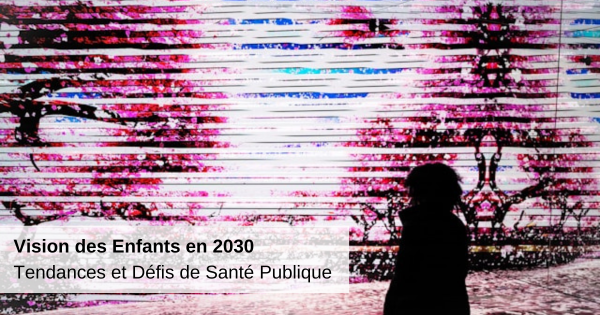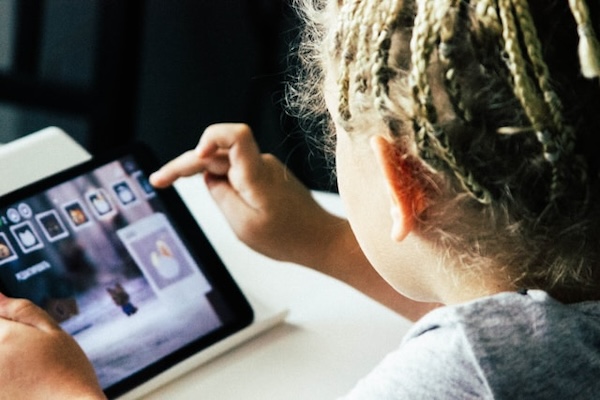Children's vision in 2030: trends and public health challenges

Children's vision is a critical issue for global public health, and the factors that influence it are evolving rapidly. Between overexposure to screens, lack of access to natural light and disparities in vision care, the challenges to be addressed by 2030 are immense. However, solutions exist to limit the harmful effects on the visual health of younger generations . On the occasion of Myopia Week , which takes place from November 18 to 24, 2024, it is crucial to explore these trends and the means to preserve children's vision by 2030. Let's analyze the impacts of screens, lighting, access to care and prevention, while questioning the future of childhood visual health.
The impact of screens on children's vision: a growing problem

Screens are a central part of children's daily lives, but their excessive use threatens their visual health. Studies show that long hours spent in front of tablets or smartphones promote eye fatigue, focusing problems and myopia. The rapid progression of this pathology makes it a real epidemic . According to the WHO, nearly 50% of the world's population could be myopic by 2050.
A key factor is the close and prolonged distance at which children use these devices, combined with a lack of visual breaks. In China, government initiatives have limited screen time to two hours per day for those under 18. These measures aim to slow the progression of myopia in young people.
In 2030, prevention will have to intensify, with an emphasis on technological solutions. For example, artificial intelligence applications already alert users to necessary breaks. Investing in these tools and educating parents to limit screen use can transform children's daily lives and preserve their vision. Good management of digital exposure, combined with appropriate visual hygiene , is essential to protect children's visual health by 2030.
Lighting and its effects on vision development

Lighting plays a fundamental role in children's eye health. However, many young people lack natural light, which increases the risk of myopia. Outdoor light stimulates the release of dopamine in the eye , slowing the excessive elongation of the eyeball, a major cause of myopia.
Studies, particularly in Singapore, show that children who benefit from at least two hours of natural light daily have a 30% reduced risk of myopia . Unfortunately, increasing urbanization and a lack of time spent outdoors are making this problem worse.
In parallel, inadequate artificial lighting can also affect vision. Schools are beginning to adopt biodynamic lighting solutions, mimicking the natural variations of daylight. These technologies help reduce visual fatigue while improving learning conditions.
By 2030, raising awareness of the importance of natural light and investing in suitable infrastructure will be essential. Promoting outdoor activities from a young age is a simple but effective way forward. Integrating visual health into educational policies could be a powerful lever to reduce the impact of this factor.
Access to vision care: a persistent disparity
Despite medical advances, many children do not receive regular eye care. Geographic and socio-economic disparities limit access to consultations and necessary equipment. In France, for example, the waiting times for an ophthalmology appointment vary greatly between rural and urban areas.
By 2030, technological initiatives such as teleconsultation could change the situation. Pilot projects show that remote consultations can reduce waiting times and better distribute resources. In addition, low-cost glasses, developed by NGOs, are already providing concrete solutions in the most disadvantaged areas.
However, these efforts must be stepped up. Better collaboration between public and private actors is crucial to ensure equitable coverage. At the same time, mobile screening campaigns, such as those organised by associations during Myopia Week, offer a promising solution for detecting visual disorders at an early stage.
Prevention and education: a key lever for the vision of children in 2030

Prevention and education are essential pillars for preserving children's vision. Raising awareness among parents, teachers and children themselves to adopt responsible behaviors is a priority.
For example, school programs that integrate regular eye breaks or specific visual exercises are already showing positive results. Interactive educational applications, such as those developed by visual health startups, teach children the importance of their eyesight and good practices to adopt.
By 2030, prevention campaigns will also have to integrate new technologies . Connected glasses or smart sensors could alert users when they spend too much time staring at a screen or adopt an incorrect posture. These innovations, combined with proactive education , could transform the way vision health is managed on a daily basis.
Investing in prevention and education now is the best guarantee for a future where vision health is no longer an obstacle to the well-being and learning of young people. Children's vision in 2030 will depend on the choices made today in terms of prevention, access to care and awareness. By acting on the factors identified – screens, lighting, and inequalities in care – it is possible to limit the extent of vision disorders and offer younger generations a better quality of life. It is therefore imperative that opticians, health professionals and decision-makers work together to meet these challenges and anticipate future needs.


